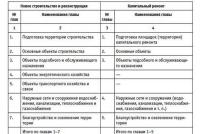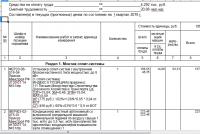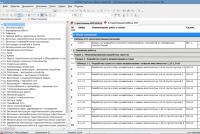Accounting entries in 1 s 8.3. Accounting entries: what they are and the principles of their preparation. Double entry principle
Data on business operations of an enterprise in the 1C: Enterprise system are stored as operations. Each transaction contains one or more transactions that fully reflect the business transaction in accounting.
Activity log
In the 1C: Enterprise system, the transaction log is used to view the list of entered accounting transactions. Each operation is displayed in one line containing the most important information about the operation: date, document type, content, transaction amount, etc.
Posting journal
The posting journal is a viewer in the form of a list of the journal entries of the entered transactions. Each transaction contains one or more transactions. If in the transaction log you can view the basic data for the transactions in the list and the transactions for the current transaction, the transaction log displays the transactions related to different transactions.
Entering and editing operations
The journal of transactions and the journal of transactions are intended for viewing as a list of existing transactions with varying degrees of detail. In both journals, there is almost the same set of actions for entering and editing operations.
Deleting (marking for deletion) of an operation (document)
Since operations in the 1C: Enterprise system belong to documents, deletion and marking for deletion in the journal of operations (postings) will be performed for the document itself. | Note that when deleting (marking for deletion) in the transaction journal, the action will not apply to the current line, but to the entire transaction (document) to which this transaction belongs.
Canceling a mark for deletion of an operation (document)
To cancel the mark for deletion of an operation (document), place the cursor on the required line in the journal and press the Del key, or click the button on the toolbar of the journal window, or select the "Unmark for deletion" item in the "Actions" menu of the main program menu.
Change of time of operation (document)
All documents (including operations entered manually) in 1C: Enterprise form a single sequence. It actually reflects the sequence of events that are reflected in documents and transactions. | Time is used to determine the sequence of documents within one date.
Go to the transaction log and the transaction log
When working in the journal of transactions, the journal of transactions and in the form of an operation, it is possible to go to the journal of transactions and the journal of transactions. In this case, the current position is selected in accordance with the current position in the form from which the transition is performed.
Turning transaction transactions on and off
Those transactions that contain transactions affect the calculation of accounting totals. If you wish, you can exclude the operation from the calculation of totals. To do this, just select the desired operation in the journal of transactions (transactions), and then select the "Disable transactions" item in the "Actions" menu.
Checking journal entries
1C: Enterprise has a special mode "Correct transactions", which allows you to define a list of acceptable transactions at the level of synthetic accounts and then check the transactions for compliance with the entered list.
Actions on documents
Since transactions and, accordingly, transactions belong to documents, then when working in the journal of transactions and in the journal of transactions, almost all actions that can be performed with documents in the document journal are available. These actions are called by various items of the "Document" submenu of the "Actions" menu.
Send this article to my mail
Most 1C: Accounting configuration documents generate postings in the program, several postings can correspond to one document at once, and the same posting can be formed by different documents.
In accounting practice, there are situations when you need to reflect a business transaction by entering a posting, but there is no document for this in the program, in such cases manual input of the necessary correspondence is allowed.
If you have questions about wiring in 1C, ask them in the comments under the article, our experts will try to answer them.
However, if you are a newbie in the accounting department or the 1C program and do not understand which document should be used to reflect this or that business transaction, do not rush to enter them using manual entries, this can lead to a violation of accounting. In order to check what document the transaction is made with (and whether there is such a document in the information system at all) there is a register called Account Correspondences. It opens in the Main section → Enter business transaction or through the menu All functions → Information registers → Invoice correspondence. It is presented in the form of a workplace in which, using selections, you can quickly search for documents on the transaction of interest to us. To do this, it is enough to specify the debit and credit accounts and the list will display documents that correspond to the specified correspondence of accounts, while the content of the operation performed by this transaction and the location of the selected documents in the 1C database (in which sections they can be found) are also displayed.
If, nevertheless, the standard option to reflect the business transaction does not work, and there is no document in the information system, you will have to make a posting in 1C Accounting manually, using a document specially designated for this purpose.
It is not difficult to make a posting in 1C Enterprise Accounting 3.0, for this you need to create a document called Operation. Open the section Operations → Operations entered manually. Next, we create a document Operation, one of its purposes is to manually register the correspondence of accounts for accounting and (or) tax accounting. When creating from the proposed options, select the Operation view.
The document is filled out quite simply, in the header you must indicate the organization and content (description of the business transaction). You do not need to fill in the Transaction amount field, its value will be calculated from the data of the rows of the tabular section as they are entered.
To fill in the tabular section, click Add and in a new line, enter the correspondence of accounts and the amount, and also, if necessary, indicate additional analytics and content for each transaction. So we add lines for each transaction.
After that, you need to check the document and if everything is correct, save it in the system by clicking Save and close. As a result, a new document will appear in the list of manually entered operations. You can check the postings made by him by clicking the Dt-Kt icon (Show postings and other document movements). You can also print out accounting information on the entered document by highlighting it in the list and pressing the Accounting Help button.
A team of experienced 1c programmers:
From 5 minutes response time to urgent tasks, even on weekends and holidays.
30+ programmers with up to 20 years of experience in 1C.
We make video instructions on the completed tasks.
Live communication through any messengers convenient for the client
Control over the implementation of your tasks through an application specially developed by us
Official partners of the 1C firm since 2006.
Experience in successful automation from small firms to large corporations.
99% of customers are satisfied with the results
1C: Accounting 8.2. A clear tutorial for beginners Gladky Alexey Anatolyevich
Business transactions and accounting entries
You can form business transactions and accounting entries in the 1C Accounting 8 program in several ways, which are listed below.
Automatically simultaneously with document posting. To do this, you need to specify the accounting entry accounts in the appropriate fields of the document editing window. Note that for some documents it is possible to form several transactions at the same time. For example, when posting the document “Receipt of goods and services”, transactions are generated separately for the amount of incoming goods and materials (work performed, services rendered) and for the amount of VAT on received values \u200b\u200b(work performed, services rendered).
NOTE
If in the document editing window there are fields for entering accounting accounts, then you can post a document on accounting only if all these fields are filled in.
Manually in the activity log. To switch to the mode of working with this log, use the Operations? Main menu command. Operation log. To enter the accounting entry manually, you need to click the Add operation button in the toolbar of the journal window, and in the window that opens, enter the parameters of the business transaction and accounting entries for it. With the help of manually generated accounting entries, you can post, for example, accounting statements.
Using the mechanism of typical operations. To switch to the mode of generating standard operations, use the Operations? Typical operations. What is the mechanism of typical operations in the program "1C Accounting 8" was discussed above, in the section "The main stages of working with the program".
In automatic mode using the "Month-end closing" document (Operations? Regular operations? Month-end closing). When forming this document, you yourself indicate which postings the program should create after it is posted. This can be, for example, the revaluation of foreign exchange funds, the accrual of depreciation, the closure of cost accounting accounts, the calculation of the financial result, etc.
Note that most often users form transactions and postings in the first of the listed ways - simultaneously with posting the corresponding document. Manual formation of postings is practiced less often and mainly - to reflect in accounting some non-standard situations drawn up by accounting certificates or other documents. Automatic generation of transactions based on the "Close of the month" document is carried out monthly.
From the book Settlements with accountable persons: accounting and taxation. author Zakharyin VR4. Basic accounting entries for accounting settlements with accountable
From the book Intangible Assets: Accounting and Tax Accounting author Zakharyin VR3. Basic accounting entries for accounting for objects of intangible assets In accounting, the following entries are made for accounting for objects of intangible assets (see.
From the book Formation of financial results in accounting author Berdyshev Sergey Nikolaevich5. Basic accounting entries on account 05 In the accounting of objects of intangible assets on account 05, the following entries are made (see.
From the book Analysis of financial statements. Cheat sheets author Olshevskaya Natalia1.5. Accounting transactions related to income accounting The most important transactions are provided with short comments. Accounts are arranged in the manner prescribed by the current Chart of accounts of financial and economic activities
From the book 1C: Accounting 8.2. A self-explanatory tutorial for beginners author Gladky Alexey Anatolievich2.5. Accounting transactions related to expense accounting The most important transactions are provided with short comments. Accounts are arranged in the manner prescribed by the current Chart of accounts of financial and economic activities
From the book ABC of accounting author Vinogradov Alexey Yurievich3.5. Accounting transactions related to profit and loss The most important transactions are provided with short comments. Accounts are arranged in the manner prescribed by the current Chart of accounts of financial and economic
From the author's book67. Business transactions Business transactions are separate economic actions performed in the course of the plan. Each operation causes a certain movement and change in the composition of funds. Some funds leave the enterprise, others
From the author's bookAccounting entries and reports on salaries As we noted earlier, accounting entries on wages, as well as on accruals and deductions, the program will automatically generate after the document is created and posted.
From the author's book6.2. Main accounting entries on account 20 "Main production" Information about the costs of production (core production of this organization) is reflected in the active account 20 "Main production". The balance of account 20 "Main production" at the end
From the author's book6.3. The main accounting entries on account 23 "Auxiliary production" To determine the cost of goods and services of auxiliary production, active account 23 "Auxiliary production" is used. Account 23 is similar to account 20. Account balance
From the author's book6.4. The main accounting entries on account 25 "General production costs" On the active account 25 "General production costs" keep records of expenses for the management and maintenance of workshops, that is, on account 25 reflect the costs of the workshop. Account 25 balance at the reporting date
From the author's book6.5. The main accounting entries on account 26 "General business expenses" On the active account 26 "General business expenses" keep records of expenses for the management and maintenance of the enterprise as a whole, that is, account 26 reflects the costs of the plant management. Account 26 balance
From the author's book6.6. Basic accounting entries on account 28 "Defect in production" Active account 28 "Defect in production" is used to record the costs of correcting the marriage and the corresponding funds spent on the final marriage. Account 28 does not have a balance at the end of the month and,
From the author's book6.7. Basic accounting entries on account 29 "Serving industries and farms" On the active account 29 "Serving industries and farms", the corresponding costs are taken into account if the enterprise has, for example, hostels, hotels,
From the author's book6.8. Basic accounting entries on account 96 "Provisions for future expenses" The most common is the reservation of wages of employees during the vacation. The fact is that vacations are provided to employees of the organization unevenly throughout the year. it
From the author's book6.9. Basic accounting entries on account 97 "Prepaid expenses" Prepaid expenses are expenses incurred in the reporting period, but in fact related to future periods. The main example of such expenses is the cost of preparing and developing a new
Contrary to the usual expression "", the user acquires under the license not the software itself, but the right to use the results of intellectual activity. This right is usually non-exclusive. In Russian accounting, according to Regulation PBU 14/2007, such a right is not recognized.
If the payment for it was a one-time, then the cost of the non-exclusive right must be attributed to (abbreviated name - RBP), then it is subject to gradual write-off to costs during the term of the contract.
It happens that there is no information about the validity period in the license agreement. Then the organization has the right to set the operating life of the software itself, this should be indicated in the accounting policy. It is recommended, according to the information letter of the company "1C", the term of use of the software products of this company should be set at 2 years.
Example. The organization acquired a license from a partner of 1C firm to use the computer program 1C: Accounting 8.3 (rev. 3.0), version of the PROF, worth 13,000 rubles. It is necessary to reflect in the same program the purchase of a non-exclusive right to use the software, attribute its cost to deferred expenses and then write off the cost to the expense account 26 "General business expenses" in two years using monthly write-off operations.
Purchase of software in 1C 8.3
We capitalize the software with the document "Receipt of goods and services", indicating the type of document - "Services (act)". When specifying an item, we will add a new item to the directory, let's call it "", the item type should be "Service".
Get 267 1C video tutorials for free:

When filling in the "Prepaid expenses" variable, you need to create a new element of the directory - a new item of prepaid expenses, indicating the program cost and write-off parameters (procedure for recognizing expenses, start date of write-off, end date of write-off of BPO, account and cost analytics):

Thus, the cost of the purchased program will be immediately included in the BPO. Let's post the document "", while it will generate a posting to the Dt of account 97.21 under the entered article "1C Accounting". (In this example, the buying organization is a VAT payer, so the posting was made for the amount of the program cost without VAT, and the VAT amount was charged to Dt 19.04):

Write-off of prepaid expenses
The operation is routine. It will be performed according to the specified parameters (procedure for recognizing expenses, period, write-off account) automatically when the monthly processing "" is performed. The program will itself determine the need to write off the BPO and calculate the amount.

When performing the operation, a transaction is generated according to the specified (in our example, account 26), the amount is calculated based on the selected start date of the write-off and the end date.
Each business entity that conducts business as a legal entity makes a large number of business transactions every day.
In accordance with the Federal legislation of Russia, all state and commercial companies (with the exception of individual entrepreneurs) are required to reflect them in the accounting records.
Posting concept
 To reflect business transactions in accounting registers, it is customary to use transactions that are corresponding correspondence of accounts.
To reflect business transactions in accounting registers, it is customary to use transactions that are corresponding correspondence of accounts.
Every specialist applying for the position of an accountant must know by heart. Thanks to this, he will be able to quickly compose a record when registering a particular operation.
What are they like?
There are two types of postings in accounting: complex and simple... When drawing up a simple version, specialists use two accounts that correspond with each other. If you have to execute a complex business transaction, accountants have to use more than two accounts.
Compiled correspondence is posted to the appropriate accounting registers (legal entities use memorial warrants, accounting records, order journals).
How to compose them? Basic principles
 When conducting accounting, specialists will use three types of accounts: active, passive and active-passive... Active enterprises should reflect cash, inventory, fixed assets and fixed assets, inventory balances, etc. Passive legal entities reflect all their obligations to the state, business partners, employees, creditors.
When conducting accounting, specialists will use three types of accounts: active, passive and active-passive... Active enterprises should reflect cash, inventory, fixed assets and fixed assets, inventory balances, etc. Passive legal entities reflect all their obligations to the state, business partners, employees, creditors.
Active-passive accounts are also designed to display business transactions, but differ in that they can simultaneously have a balance on both credit and debit. As an example, we can cite a debt (prepayment) that arises from a specific supplier to the company in parallel with the debt (received goods without payment), which is recorded by the same company to the same supplier.
When drawing up accounting entries, you need to remember the following nuances:
- active accounts can only have a debit balance, while passive accounts have only a credit balance;
- an increase in passive accounts occurs only for credit, and active accounts for debit;
- the balance on active-passive accounts can be reflected simultaneously in both liabilities and assets of the balance;
- when compiled in its right side, the balances of passive accounts are displayed, and on the left - active;
- to reduce the active account, you need to make entries on its credit, and to reduce the passive account, entries are made on debit.
Posting - a way of expressing the correspondence of accounts, the basis for which is the conducted business transaction. When compiling them, it is recommended to adhere to the following scheme:
- It is necessary to determine which accounts and accounting objects are affected by the issued transaction (its economic content is taken into account).
- It is necessary to establish which accounts will be involved in the posting (passive or active).
- The account to be credited or debited must be defined. For this, the sources of origin of the operation and all associated factors are taken into account.
When compiling simple transactions, two accounts are affected, for example, when money arrives at the company's cash desk from a current account, the following entry is made: CT 51 Dt 50. When compiling complex records, several accounting accounts are involved.
You can clearly see the procedure for drawing up transactions in the following video:
Double entry principle
The reflection of business transactions in accounting accounts by specialists is carried out using the double entry method.
The essence of this method is as follows: for each operation the accountant makes a corresponding entry simultaneously on the debit of one and the credit of another account.
Examples of transactions
 Currently, a large number of methodological manuals are regularly published for accountants, which indicate the most common entries for a particular type of activity.
Currently, a large number of methodological manuals are regularly published for accountants, which indicate the most common entries for a particular type of activity.
Using existing examples, specialists will be able to avoid the most common mistakes when compiling correspondence of accounts and posting them to the appropriate accounting registers.
By wages
When drawing up transactions for transactions, the essence of which is to settle accounts with employees, specialists should make the following correspondence of accounts:
Rent of premises
When transferring an area or building for lease, records are made by both the owner of the fixed asset and the tenant. They draw up correspondence of invoices for any action related to the leased property.
The main ones are shown in the table:
| Debit | Credit | |
|---|---|---|
| 01 (subaccount "fixed assets leased") | Leased premises | 01 |
| 20 | Amortization accrued on the transferred premises | 02 |
| 50, 51 | Rent received | 62 |
| 90 (sub-account 2) | Depreciation and other lease-related expenses written off | 20 |
| 001 | The tenant received the premises | |
| 76 | Listed rent | 51 |
| 44, 29, 26, 25, 23, 20 | Lease debt | 76 |
Wholesale and retail trade
When carrying out business activities related to the sale of goods, finished products, works or services, legal entities make up a lot of transactions.
To reflect transactions in this area in accounting, the following entries must be made:
| Debit | The content of the business transaction | Credit |
|---|---|---|
| Money is transferred: | ||
| 62 | return of advance payment to buyers | 51, 50 |
| 61 | suppliers | 51, 50 |
| 45 | Goods shipped to buyers | 41/1 |
| 41/1,41/2 | Received goods from suppliers | 60 |
| Reflected VAT | ||
| 19 | for goods received | 60 |
| 41/2 | in retail | 60 |
| 90/03 | for goods shipped | 68 |
| 90/03 | in retail | 68/02 |
| 62 | Reflected implementation | 90/01.1 |
| 92.R | retail | 90/01.1 |
| 91/02.1 | Reflected the cost of goods shipped | 45 |
| 91/02.1 | in retail | 41/1 |
Assignment agreement
When drawing up this agreement, an accountant of any commercial organization carrying out economic activities in the status of a legal entity must draw up correspondence of accounts.
The following postings are used for such transactions:
| Debit | The content of the business transaction | Credit |
|---|---|---|
| 58 | The value of all rights acquired by the company under the cession agreement signed between the parties is reflected | 76 |
| 76 | The debt that arises to the assignor is repaid in whole or in part | 51, 50 |
| 50, 51 | Debt received from the debtor to the current account or to the company's cash desk | 76 |
| 76 | The amount of all repaid debt is taken into account as part of income | 91/1 |
| 91/2 | Accounting for acquired rights of claim as part of expenses | 58 |
Cash transactions
Business entities must draw up documents and in accordance with the CSP in force in the territory of the Russian Federation.
To compile correspondence, the accountant uses the following accounts:
- 50 - cash desk;
- 51 - current account;
- 70 - payroll calculations;
- 73 - other calculations;
- 62 - settlements with customers;
- 75 - replenishment of the authorized capital;
- 71 - settlements with accountable persons;
- 91 - reflection of exchange rate differences;
- 94 - reflection of shortages;
- 76 - other payments.
| Debit | The content of the business transaction | Credit |
|---|---|---|
| 71 | Issued money to accountable persons | 50 |
| 50 | Unused reporting amounts returned to the cashier | 71 |
| 70 | Salary issued | 50 |
| 50 | Received money from the current account | 51 |
| 50 | Buyers paid for the item | 62 |
| 50 | Founders have replenished the authorized capital | 75 |
| 94 | Shortage written off | 50 |
| 91 | Reflected exchange rate differences | 50 |
Service
When providing services by business entities, acceptance certificates are drawn up. In the event that a legal entity is a payer of value added tax, it is obliged to write out according to which VAT is deducted.
The following entries are made in accounting:
With fixed assets
If a business entity has fixed assets on its balance sheet, which it uses in the implementation of economic activities, it must make correspondence of accounts as follows:
| Debit | The content of the business transaction | Credit |
|---|---|---|
| 01 | Fixed assets received from suppliers have entered the balance sheet | 60 |
| 60 | Billed invoices | 51 |
| 07 | Shown related costs | 60, 76 |
| 07,19/1 | All taxes and fees are reflected | 68 |
| 91/2 62 | Fixed assets sold | 01 91/1 |
| 51 | Funds from the buyer are transferred | 62 |
| 91/2 | VAT charged | 68 |
| 02 | Accrued depreciation written off | 01 |
Closing the year
At the end of each reporting year, the accountant is required to make special entries that will allow some accounts to be closed. This procedure is called balance reformation, it represents the reset of some of the accounts.
Without fail, specialists need to close accounts 90, 91, 99 and draw up the following correspondence:
Taxes and state duties
Each business entity when doing business is faced with the need to charge and transfer taxes, mandatory payments and fees to the budget. Also, legal entities have to pay a state fee when processing documents or receiving any services in government agencies.
In accounting, they are required to reflect every business transaction related to taxes, fees and duties:
| Debit | The content of the business transaction | Credit |
|---|---|---|
| 68 | Transfer of state fees | 51 |
| 99 | Calculation of income tax | 68 |
| 70 | Personal income tax withheld | 68 |
| 68 | Transfer of taxes to the budget | 51 |
| 91/2 | Transport tax charged | 68 |
| 90/3, 91/2 | VAT charged on sale | 68, 76 |
| 68 | VAT paid | 51 |
Loans issued
When accounting for loans, which have recently become actively issued to both full-time employees and business partners, the following records are compiled:
Acquiring
In recent years, Russian companies have begun to increasingly use acquiring in their work, which allows them to accept bank cards from buyers (when paying for goods, works or services sold). When carrying out this type of calculations, accountants may encounter various problems that relate to the process of drawing up transactions.
Using typical correspondence of accounts, they will be able to minimize the risk of making mistakes, which often cause penalties:
| Debit | The content of the business transaction | Credit |
|---|---|---|
| 62 | Sale of goods | 90/1 |
| 90/3 | VAT amount is taken into account | 68/3 |
| 57 | Settlements with the buyer are closed (documents are transferred to the acquiring bank) | 62 |
| 57 | The received proceeds from the buyer who paid for the goods with a payment card is reflected | 90/1 |
| 51 | Received money from the acquiring bank | 57 |
| 91 | Related expenses written off | 57 |
| 96 | Purchase returns | 62 |
| 20/1 | The bank received a statement from the buyer | 57 |
| 57 | Funds transferred | 51 |
| 57 | The commission charged by the bank is being adjusted | 91 |






